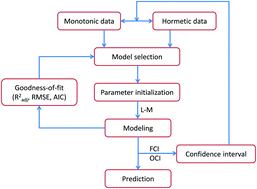JSFit: a method for the fitting and prediction of J- and S-shaped concentration–response curves†
Abstract
Most monotonic S-shaped concentration–response curves (CRCs) can be satisfactorily described by a classical Hill equation. However, the Hill equation cannot effectively describe the non-monotonic J-shaped CRCs that display stimulation at low concentrations and inhibition at high concentrations. On the other hand, the physical meaning of the model parameters in current models describing the J-shaped CRCs is not very clear. It is well known that both toxicity experiments and the fitting process inevitably produce uncertainty. To effectively deal with the J-shaped concentration–response data with uncertainty and make the model parameters meaningful, we developed a method for the fitting of the J-shaped and/or S-shaped concentration–response data (simply called JSFit). The JSFit first uses one Hill equation (S-shaped) or combines with two Hill equations (J-shaped) for fitting, then nonlinear least squares fitting is performed by means of the Levenberg–Marquardt algorithm, and finally the observation-based confidence intervals of the fitting curve are constructed by the delta procedure. For the convenience of application, we wrote a computational program (JSFit) using the MATAB programming language and introduced automation of the initial parameters into the program. The JSFit was then successfully used in the fitting and prediction of the toxic data of pesticides, ionic liquids, antibiotics, and personal skin-care products on Vibrio Qinghaiensis sp.-Q67.



 Please wait while we load your content...
Please wait while we load your content...